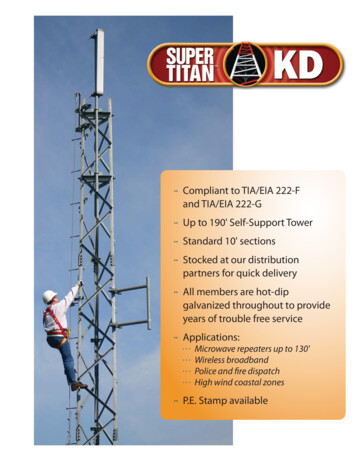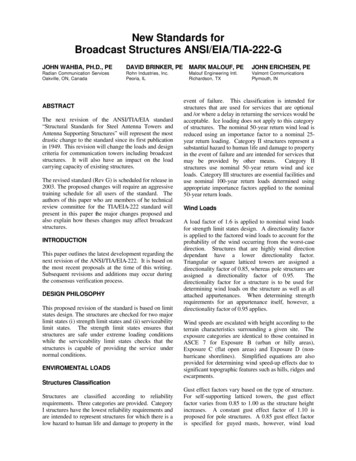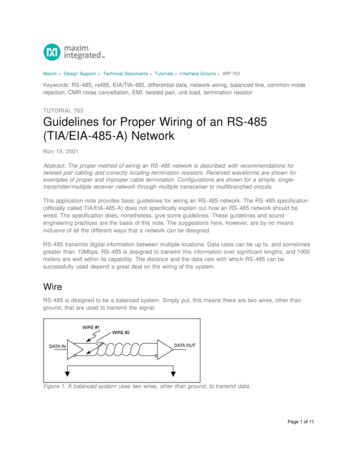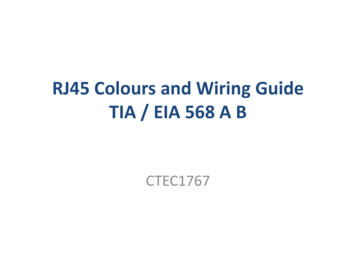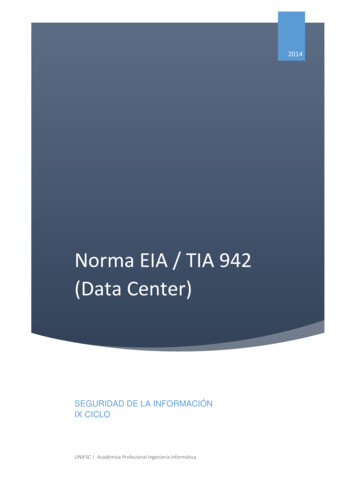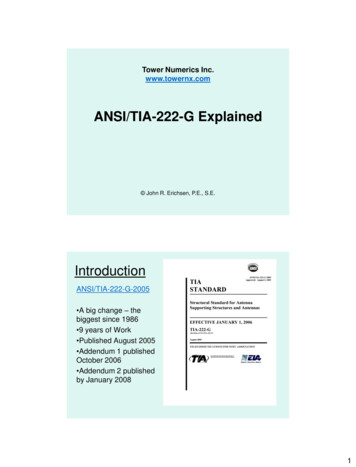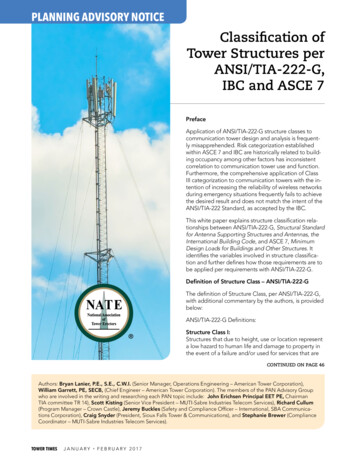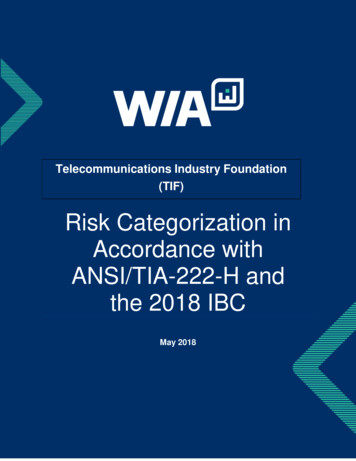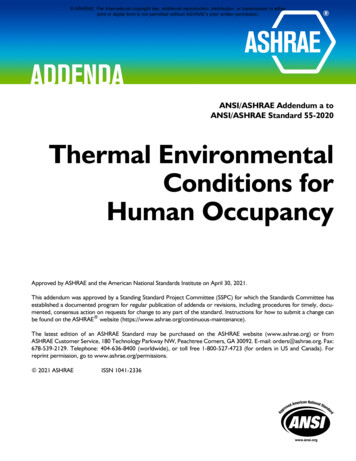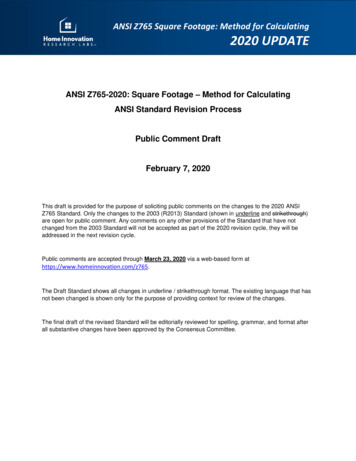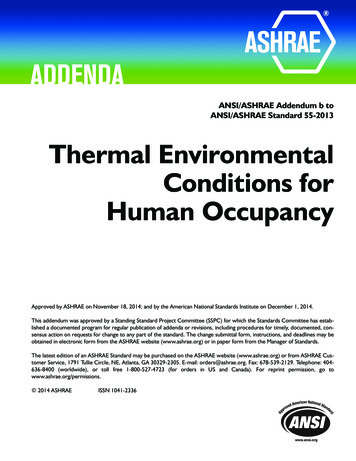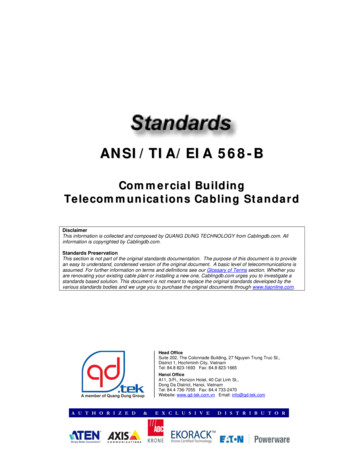
Transcription
ANSI/TIA/EIA 568-BCommercial BuildingTelecommunications Cabling StandardDisclaimerThis information is collected and composed by QUANG DUNG TECHNOLOGY from Cablingdb.com. Allinformation is copyrighted by Cablingdb.com.Standards PreservationThis section is not part of the original standards documentation. The purpose of this document is to providean easy to understand, condensed version of the original document. A basic level of telecommunications isassumed. For further information on terms and definitions see our Glossary of Terms section. Whether youare renovating your existing cable plant or installing a new one, Cablingdb.com urges you to investigate astandards based solution. This document is not meant to replace the original standards developed by thevarious standards bodies and we urge you to purchase the original documents through www.tiaonline.com.Head OfficeSuite 202, The Colonnade Building, 27 Nguyen Trung Truc St.,District 1, Hochiminh City, VietnamTel: 84.8 823-1693 Fax: 84.8 823-1665Hanoi OfficeA11, 3/Fl., Horizon Hotel, 40 Cat Linh St.,Dong Da District, Hanoi, VietnamTel: 84.4 736-7055 Fax: 84.4 733-2470Website: www.qd-tek.com.vn Email: info@qd-tek.comA U T H O R I Z E D&E X C L U S I V ED I S T R I B U T O R
ANSI/TIA/EIA 568-BCommercial Building Telecommunications Cabling StandardTable of ContentsANSI/TIA/EIA-568-B.1COMMERCIAL BUILDINGTELECOMMUNICATIONS CABLING STANDARDGeneral RequirementsANSI/TIA/EIA-568-B.2100 OHM TWISTED PAIR CABLINGSTANDARDSBackboneConnecting HardwareCords and AL FIBER STANDARDSOptical Fiber Cabling ComponentsAddendumsANSI/TIA/EIA-568-B.1-1Patch Cord Bend RadiusANSI/TIA/EIA-568-B.1-2Grounding & BondingANSI/TIA/EIA-568-B.1-3Supportable Distances for Optical FiberANSI/TIA/EIA-568-B.1-4Recognition of Category 6 & 850 LaserOptimized 50/125µm Multimode Optical FiberCablingANSI/TIA/EIA-568-B.2-1Category 6ANSI/TIA/EIA-568-B.2-2Revisions to TIA/EIA-568-B.2ANSI/TIA/EIA-568-B.2-3Additional Considerations for Insertion Lossand Return Loss Pass/Fail DeterminationANSI/TIA/EIA-568-B.2-4Solderless ConnectionReliability Requirements for Copper s to TIA/EIA-568-B.2-5ANSI/TIA/EIA-568-B.3-1Additional Specifications for 50/125µm FiberOptic CablesTransmission Parameter ChartsCategory ategoryCategoryCategory5e5e5e666666Cabling, Connecting Hardware, Permanent Link andChannelCabling and Connecting HardwareCordsPermanent Link and ChannelCableConnecting HardwareDelay SkewPatch CordPermanent LinkChannelQuang Dung Technology Distribution CompanyPage 2 of 62
ANSI/TIA/EIA 568-BCommercial Building Telecommunications Cabling StandardANSI/TIA/EIA-568-B.1Commercial Building TelecommunicationsCabling StandardGeneral RequirementsHORIZONTAL CABLINGThe definition of horizontal cabling is that portion of the cabling system that extendsfrom the work area outlet, through the cabling in the wall/ceiling/floor and then to thepatch panel in the telecommunications room. The system also includes the patchcords at the work area outlet, and patch cords in the telecommunications room. Whenprovisioning for the horizontal cabling system the designer should also consider voice,fire/safety, video, HVAC and EMS.A good design should be aimed at minimizing relocations and maintenance of thehorizontal system as it is much more costly to do it later.TopologyHorizontal cabling will be installed in a star topology, with each work area outlet beingconnected via the horizontal cable to the horizontal cross connect in thetelecommunications room. Each floor should have its own telecommunications closet,sized as per ANSI/TIA/EIA 569.Any devices required such as baluns and impedance matching devices should not beinstalled in the horizontal system, but rather, kept external to the telecommunicationsoutlet. This will facilitate network changes.Only one transition point or consolidation point between the horizontal cross connectand the telecommunications outlet shall be allowed, and bridged taps and splices arenot allowed in the copper horizontal.Cable LengthThe maximum distance between the telecommunications outlet and the horizontalcross connect shall be no more than 90 meters. The maximum length of all patchcords and jumpers in the telecommunications closet shall be no more than 5 meters,and the total length of all patch cords both in the telecommunications closet and atthe work area shall be no more than 5 meters.Recognized Cablesa. 4-pair 100 ohm unshielded twisted pair (UTP) or screened twisted pair (ScTP).b. two or more multimode optical cables, either 62.5/125 or 50/125150 ohm shielded twisted pair (STP-A) is a recognized cable type but is notrecommended for new cabling installations.All jumpers, patch cords, equipment cords shall meet all applicable standards asspecified in ANSI/TIA/EIA 568-B.2 and B.3.When hybrid and bundled cables are used, each cable type will meet the requirementsfor that cable type, and the bundled or hybrid cable will meet the specifications forbundled cables. Both of the above requirements are located in ANSI/TIA/EIA 568-B.2and B.3.Telecommunications OutletsQuang Dung Technology Distribution CompanyPage 3 of 62
ANSI/TIA/EIA 568-BCommercial Building Telecommunications Cabling StandardEach individual work area shall be serviced with a minimum of twotelecommunications outlets. One will be associated with voice and the other data. Oneoutlet will be a 4 pair 100 ohm UTP cable rated category 3 or higher. Category 5e isrecommended. The other outlet will be either a 4 pair 100 ohm UTP category 5e, or 2multimode fibers, either 50/125 or 62.5/125 micron fibers. All connectors must meetall ANSI/TIA/EIA 568-B.2 and B.3 requirements.GroundingThe system must be bonded and grounded as per ANSI/TIA/EIA 606.Backbone CablingGeneralBackbone cabling provides interconnections between telecommunications rooms,equipment rooms, and entrance facilities. It consists of the cabling, copper and/orfiber, the terminations, patch cords, jumper cords, intermediate and main crossconnects.Backbone cabling is expected to serve the needs of the user for 3-10 years based oncurrent and future needs.TopologyThe backbone cabling will be laid out in a hierarchical star so that each horizontalcross connect is connected to the main cross connect or to an intermediate crossconnect and then to a main cross connect. There can be no more than twohierarchical levels of cross connects in the backbone. No more than one cross connectshall be passed through between the horizontal cross connect and the main crossconnect. This means that between any two horizontal cross connects, the signal mustpass through 3 or fewer cross connect facilities.Recognized CablesThe following cables are recognized in the backbone and may be used on their own,or in combination.a. 100 ohm twisted pair cableb. either 50/125 micron or 62.5/125 micron multimode fiber.c. Singlemode fiber.All patch cords, jumpers, connecting hardware must meet ANSI/TIA/EIA-568-B.2 andB.3.Backbone Cabling DistancesThe distances in the table below are inclusive of cable, patch cords, jumpers andequipment cable.Maximum Backbone DistanceMedia TypeMain to Horizontal Main to IntermediateCross ConnectCross ConnectIntermediate toHorizontal CrossConnectCopper(Voice)800 m (2,624 ft)500 m (1640 ft)300 m (984 ft)MultimodeFiber2000 m (6560 ft)1700 m (5575 ft)300 m (984 ft)Quang Dung Technology Distribution CompanyPage 4 of 62
ANSI/TIA/EIA 568-BSinglemodeFiber3000 m (9840 ft)Commercial Building Telecommunications Cabling Standard2700 m (8855 ft)300 m (984 ft)Jumper and Patch Panel LengthsMain cross connect jumper and patch cords should not exceed 20 meters.Intermediate cross connect jumper and patch cords should not exceed 20 meters.Equipment jumpers should not exceed 30 meters.Grounding and BondingGrounding and bonding practices as per ANSI/TIA/EIA 607 should be followed.Work AreaGeneralThe work area components are those that extend from the work area outlet to thetelecommunications device(s).100-Ohm Balanced Twisted-Pair Telecommunications Outlet/ConnectorEach 4 pair cable shall be terminated on an 8 position modular jack, and all UTP andScTP telecommunications outlets shall meet the requirements of IEC 60603-7, as wellas ANSI/TIA/EIA 568-B.2 and the terminal marking and mounting requirements ofANSI/TIA/EIA-570-A.There are two recognized pin out assignments, T568A and T568B.Optical Fiber Telecommunications OutletHorizontal fiber shall be terminated in a duplex outlet meeting ANSI/TIA/EIA 568-B.3.The 568SC was specified in ANSI/TIA/EIA 568A-A and is still recommended. As wellother connectors such as some small form factor connectors may be used.Work Area CordsThe maximum length of a work area patch cord is 5 meters. Generally, the patch cordwill have similar connectors on each end. If additional devices are required, such asadapters, they will not be part of the horizontal cabling system, but rather beconnected via the patch cord.Open Office CablingThe open office cabling recognizes that some offices are faced with regularreconfigurations and require a more flexible cabling system to facilitate thesechanges.Multi-user Telecommunications Outlet-MUTOAThe MUTOA is used where there are frequent changes in office layout. The MUTOAallows the horizontal cable to remain undisturbed while allowing officeQuang Dung Technology Distribution CompanyPage 5 of 62
ANSI/TIA/EIA 568-BCommercial Building Telecommunications Cabling Standardrearrangements. The work area cables originating from the MUTOA are connecteddirectly to the station equipment without the use of any additional connections.The MUTOA:1. Should be located in an area so that each furniture cluster is served by at least 1MUTOA.2. Should serve a maximum of 12 work areas.3. Will have a maximum work area cable length.4. Shall be attached to a permanent part of the building5. Shall not be located in the ceiling or furniture, unless that part of the furniture ispermanently affixed to the building.AdministrationThe MUTOA is are administered as in ANSI/TIA/EIA-606. The work area cablesconnecting a MUTOA to a device are to be assigned a unique identifier and the cableshall be labelled at both ends. The outlet end shall identify the work area it servesand the work area end shall identify which MUTOA it is connected to, and what porton the MUTOA.When a MUTOA is used the horizontal cable maximum length will be affected, basedon the length of the work area cord. The maximum length of the work area cord is 22meters. For purposes of calculating the horizontal cable and the work area cord, theformula is:C (102 - H)/(1 D)Where:C maximum combined length of the work area cable, equipment cable and patchcordH the length of the horizontal cable (H C 100)D the derating factor for the patch cord type. (.2 for 24AWG UTP and ScTP, and .5for 26 AWG ScTP)There is a second formula for calculations which is not shown here.Maximum Work Area Cable LengthLength of HorizontalCableMaximum Length ofWork Area CableMaximum Combined Lengthof All Patch and EquipmentCordsMeters (Ft)Meters (Ft)Meters (Ft)90 (295)5 (16)10 (33)85 (279)9 (30)14 (46)80 (262)13 (44)18 (59)75 (246)17 (57)22 (72)70 (230)22 (72)27 (89)For fiber optic cables, a reduction of the total 100 meters is not required.Consolidation PointQuang Dung Technology Distribution CompanyPage 6 of 62
ANSI/TIA/EIA 568-BCommercial Building Telecommunications Cabling StandardA consolidation point is an interconnection point within the horizontal cabling usingcompliant connecting hardware. It requires an additional connection point(telecommunications outlet). Cross connects cannot be used at a CP and no morethan 1 CP is permitted in a horizontal run, nor can a CP and transition point be usedin the same horizontal run. The CP should be located a minimum of 15 meters fromthe telecommunications room to reduce the effects of NEXT and return loss.The CP should be located in a fully accessible and permanent location.Administration of the CP should follow ANSI/TIA/EIA 606.Telecommunications RoomsGeneralConsult ANSI/TIA/EIA 569 for design and provisioning requirements fortelecommunication rooms.The telecommunications room may contain horizontal cable, backbone cable and theirconnecting hardware, intermediate cross connect or main cross connect for portionsof the backbone system. The TR also provides environmental control for thetelecommunications equipment and splice closures as they relate to the building.Cross Connection and InterconnectionAll connections between horizontal cabling and backbone cables shall be crossconnects. All connecting hardware and cables shall meet the requirements ofANSI/TIA/EIA 568-B.2 and B.3.An interconnection will connect the connecting hardware of the horizontal cable (patchpanel) to the telecommunications equipment (eg: hub).A cross connect will have the connecting hardware of the horizontal system (eg: patchpanel) connected to connecting hardware (patch panel), which is in turn connected tothe common equipment.Equipment RoomsEquipment rooms differ from telecommunications rooms in that the ERs generallycontain more complex equipment, but an ER may also be a telecommunications room.Equipment rooms must conform to ANSI/TIA/EIA 569 requirements.An equipment room may also contain main cross connects, the intermediate crossconnect used in the backbone hierarchy.The ER may also act as a telecommunications room and house the horizontalterminations, telephone provider terminations, premise network terminations andother miscellaneous terminations.Entrance Facilities (EF)GeneralThe entrance facilities serve as the entrance point for the outside plant cable from avariety of sources such as the telephone company, private network cables and otheraccess providers. It also houses network protection devices, and may act as thedemarcation point for the regulated access provider.The E
ANSI/TIA/EIA 568-B Commercial Building Telecommunications Cabling Standard Disclaimer This information is collected and composed by QUANG DUNG TECHNOLOGY from Cablingdb.com. All information is copyrighted by Cablingdb.com. Standards Preservation This section is not part of the original standards documentation. The purpose of this document is to provide an easy to understand,
